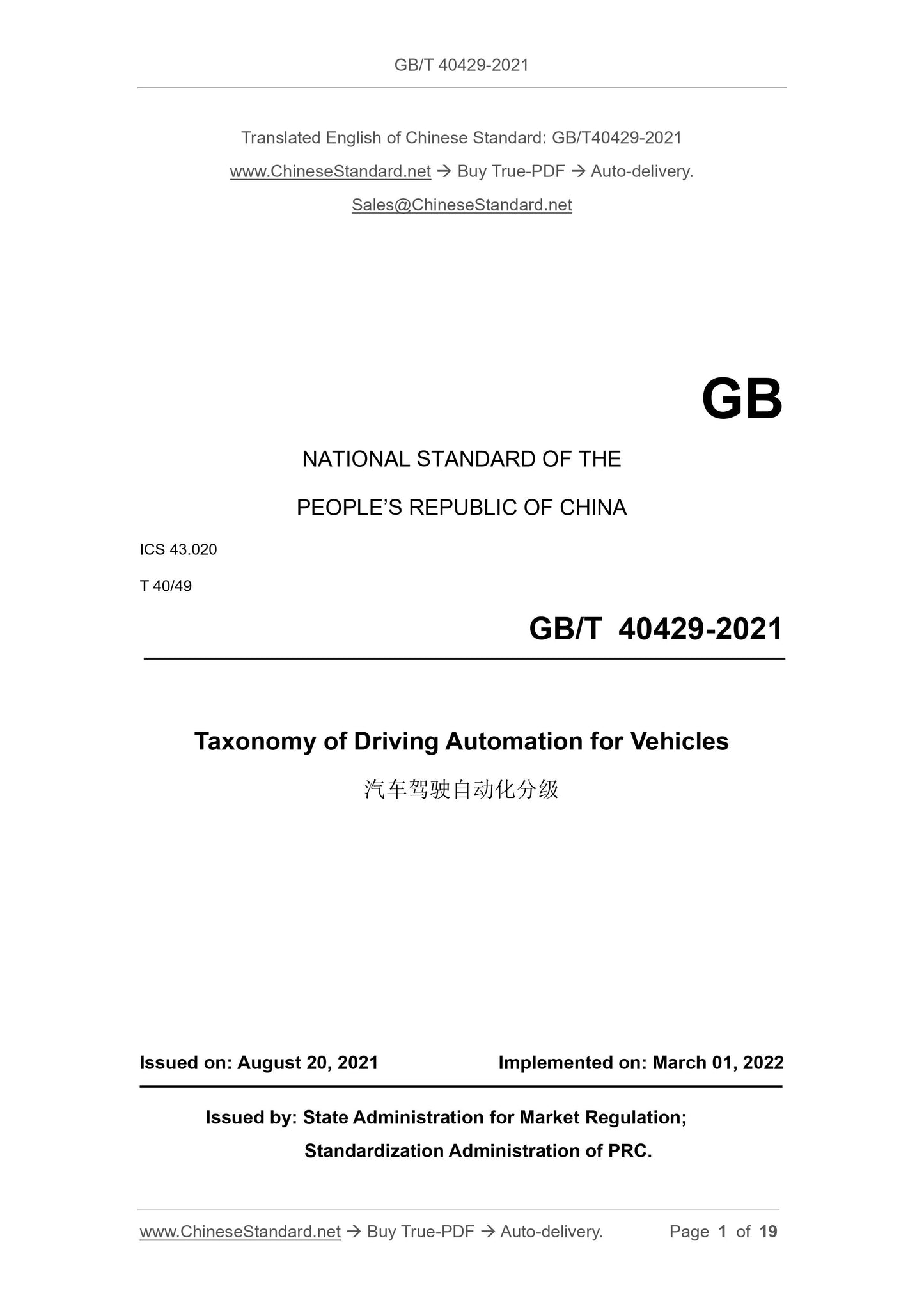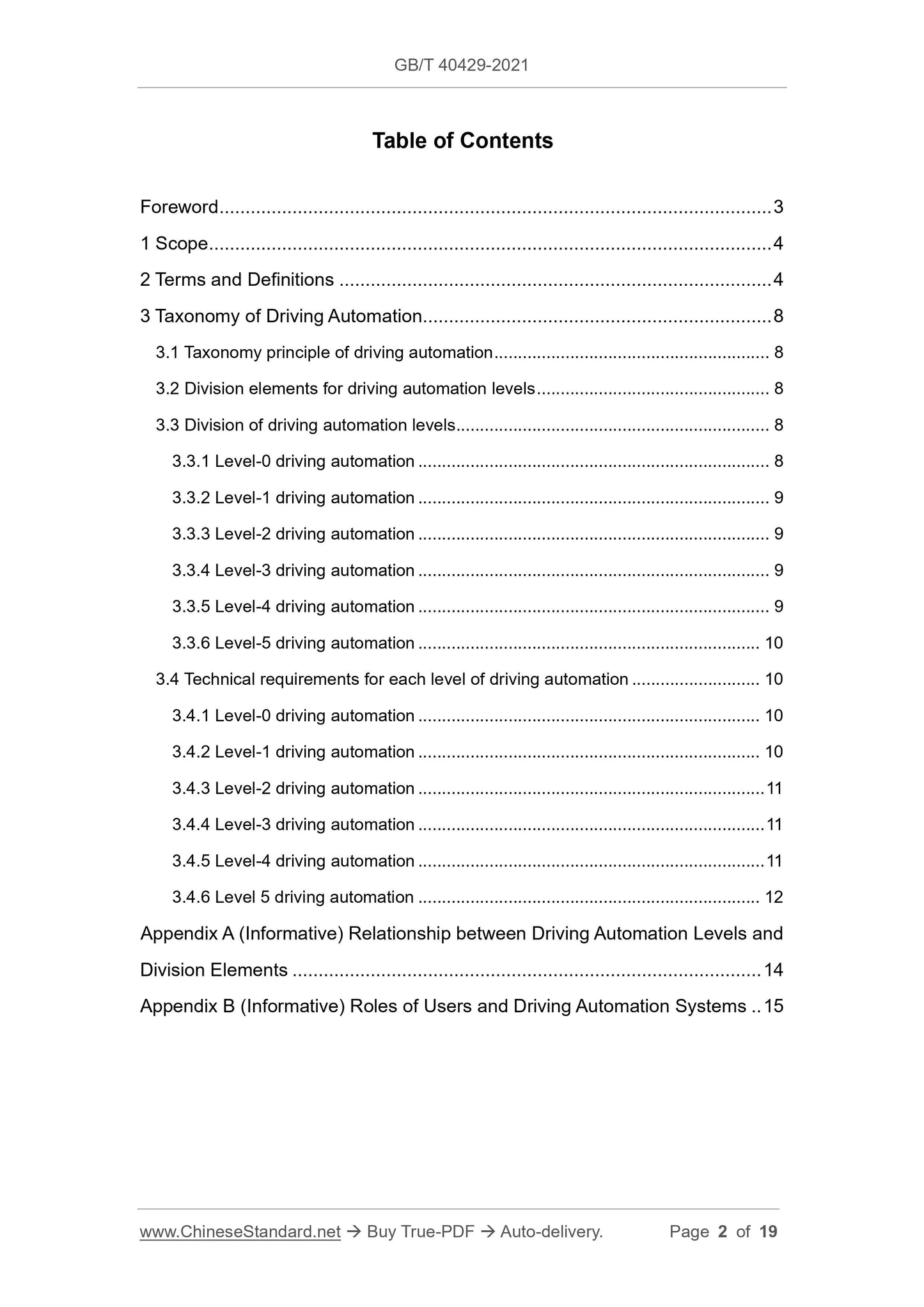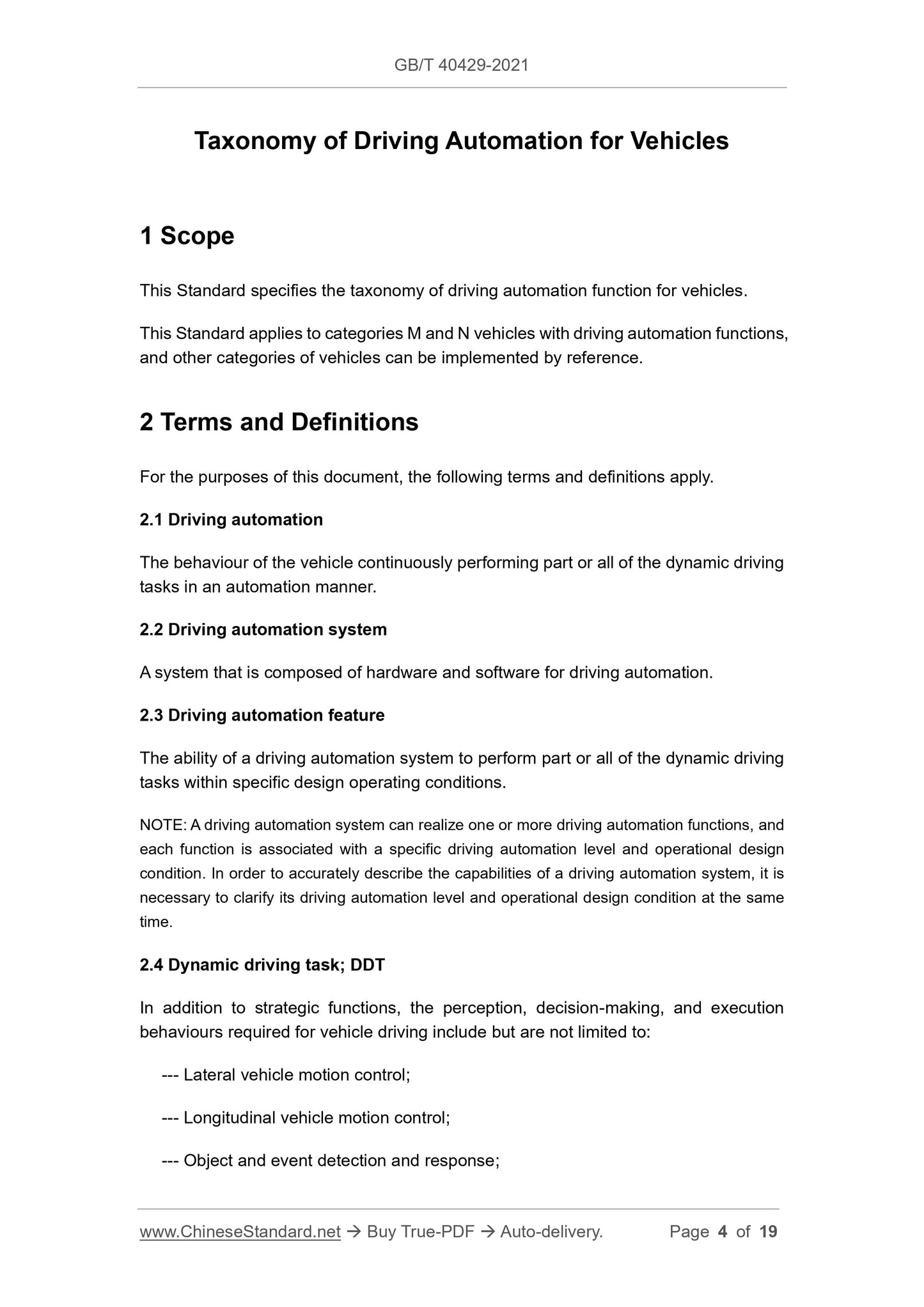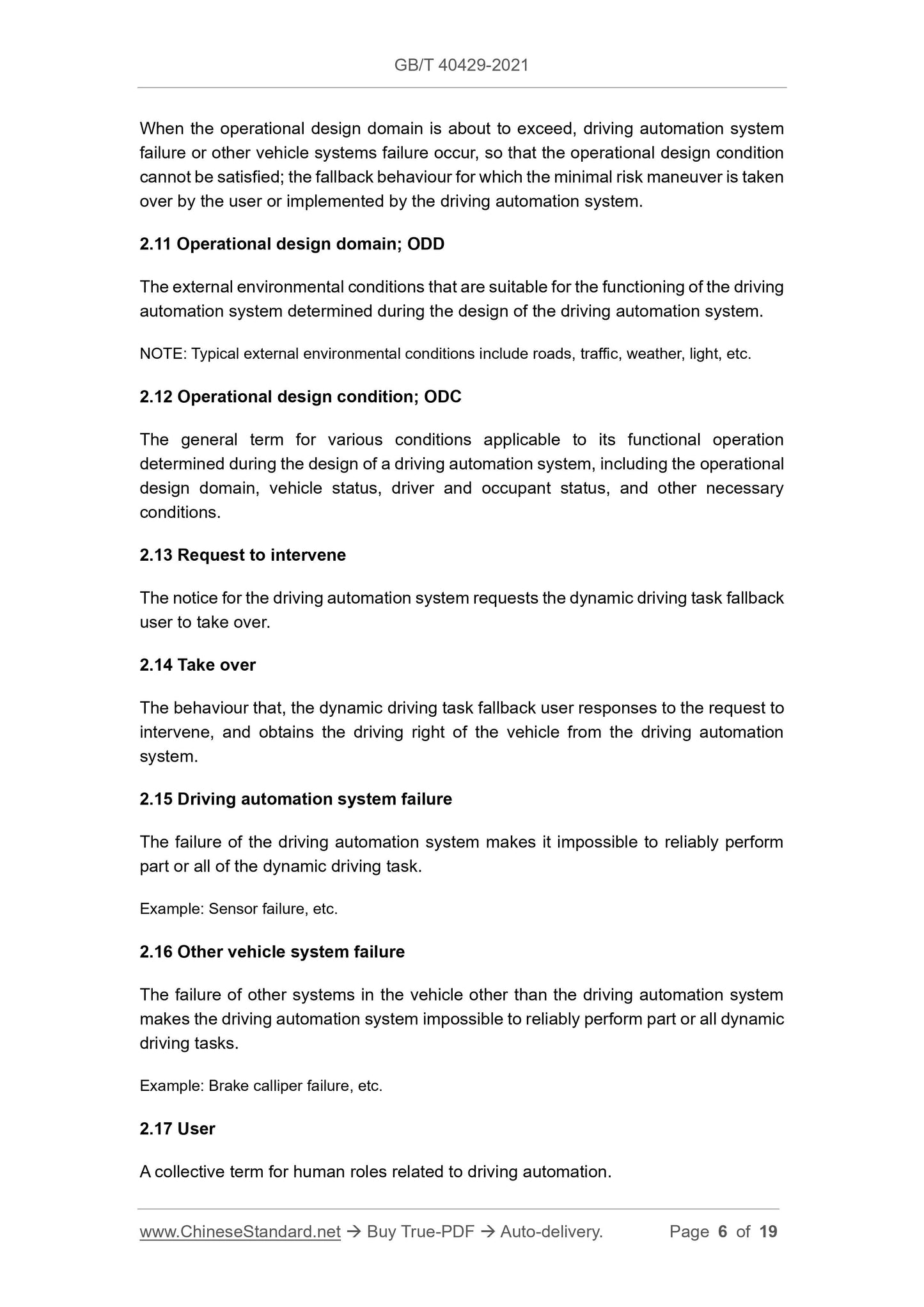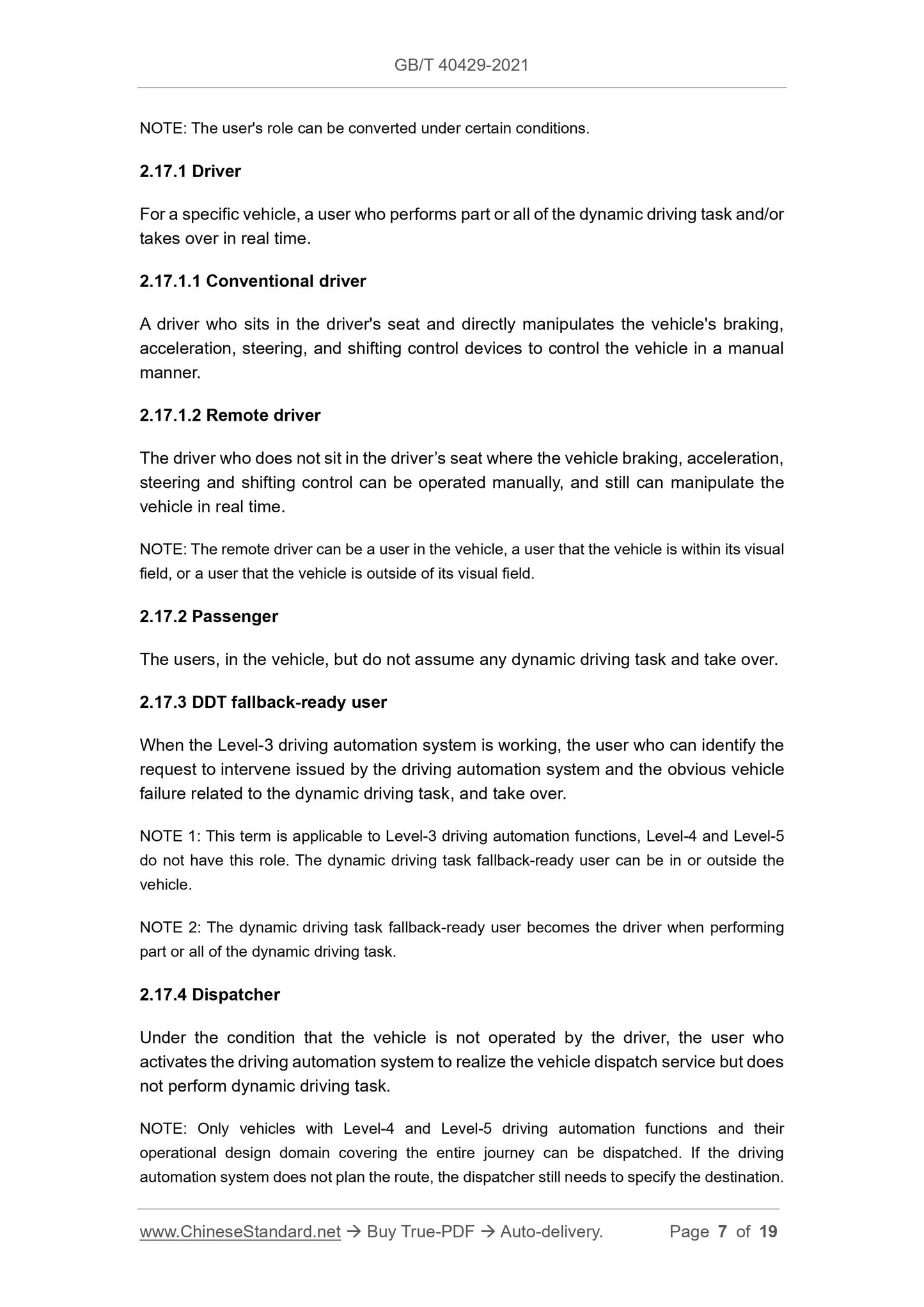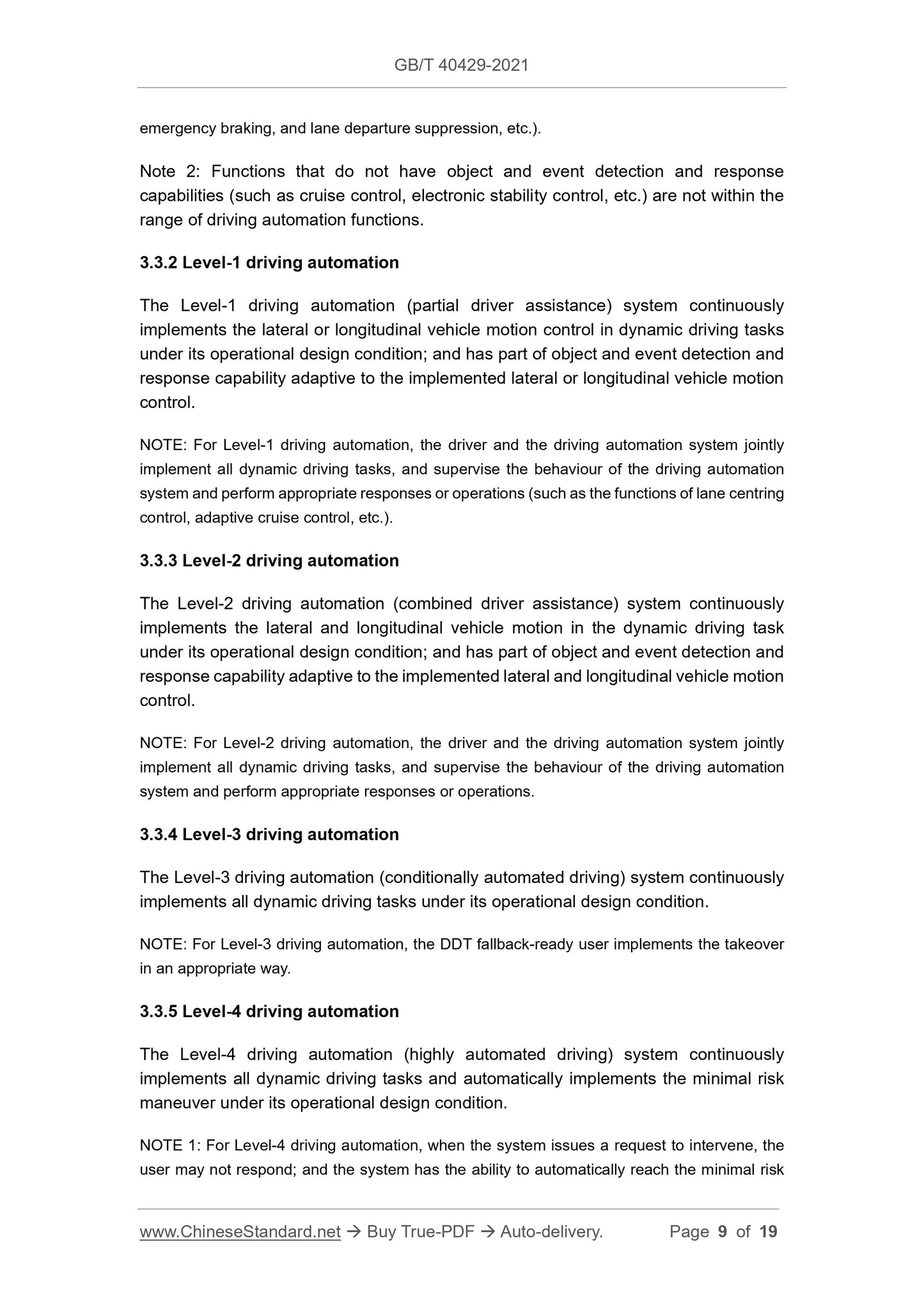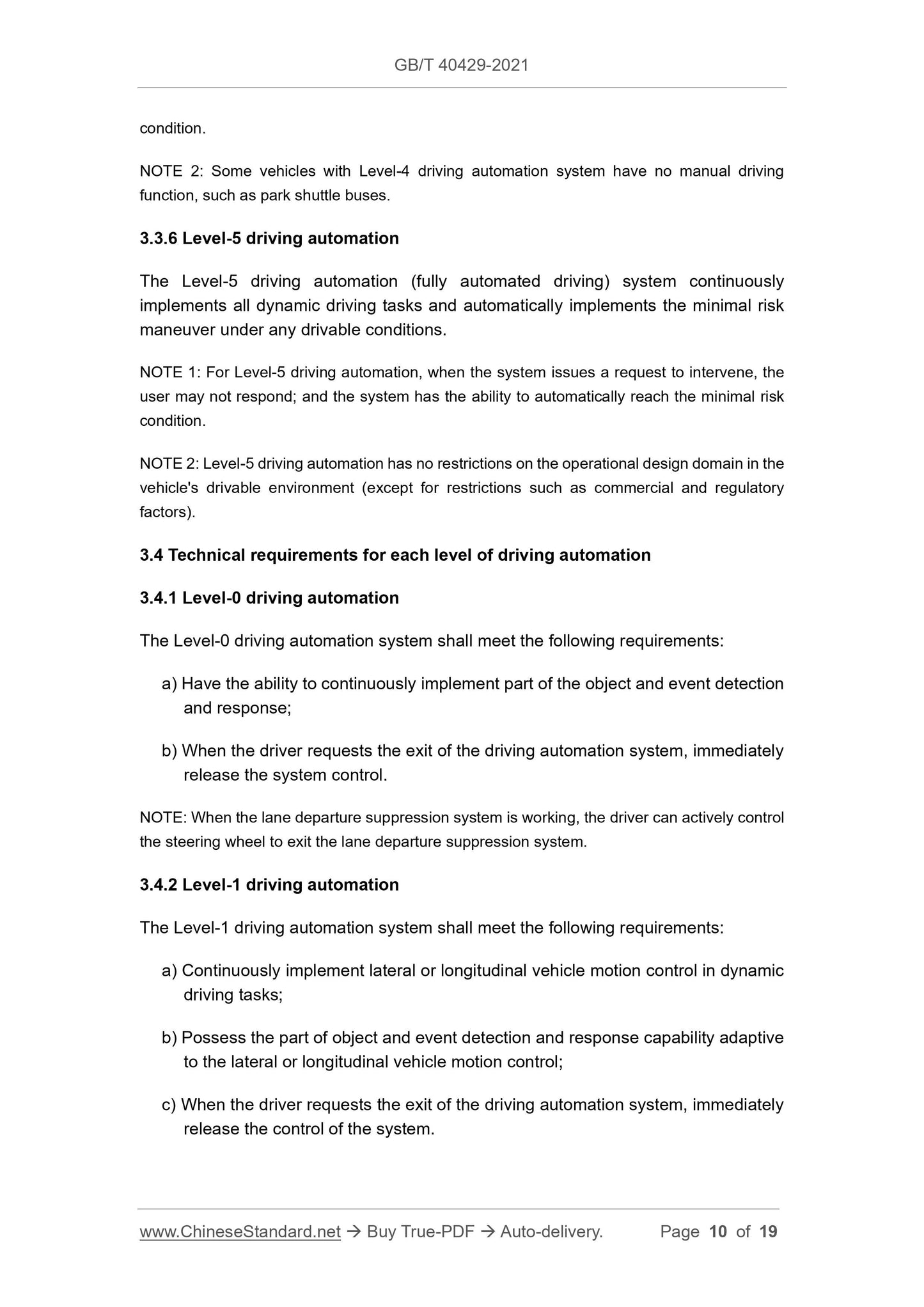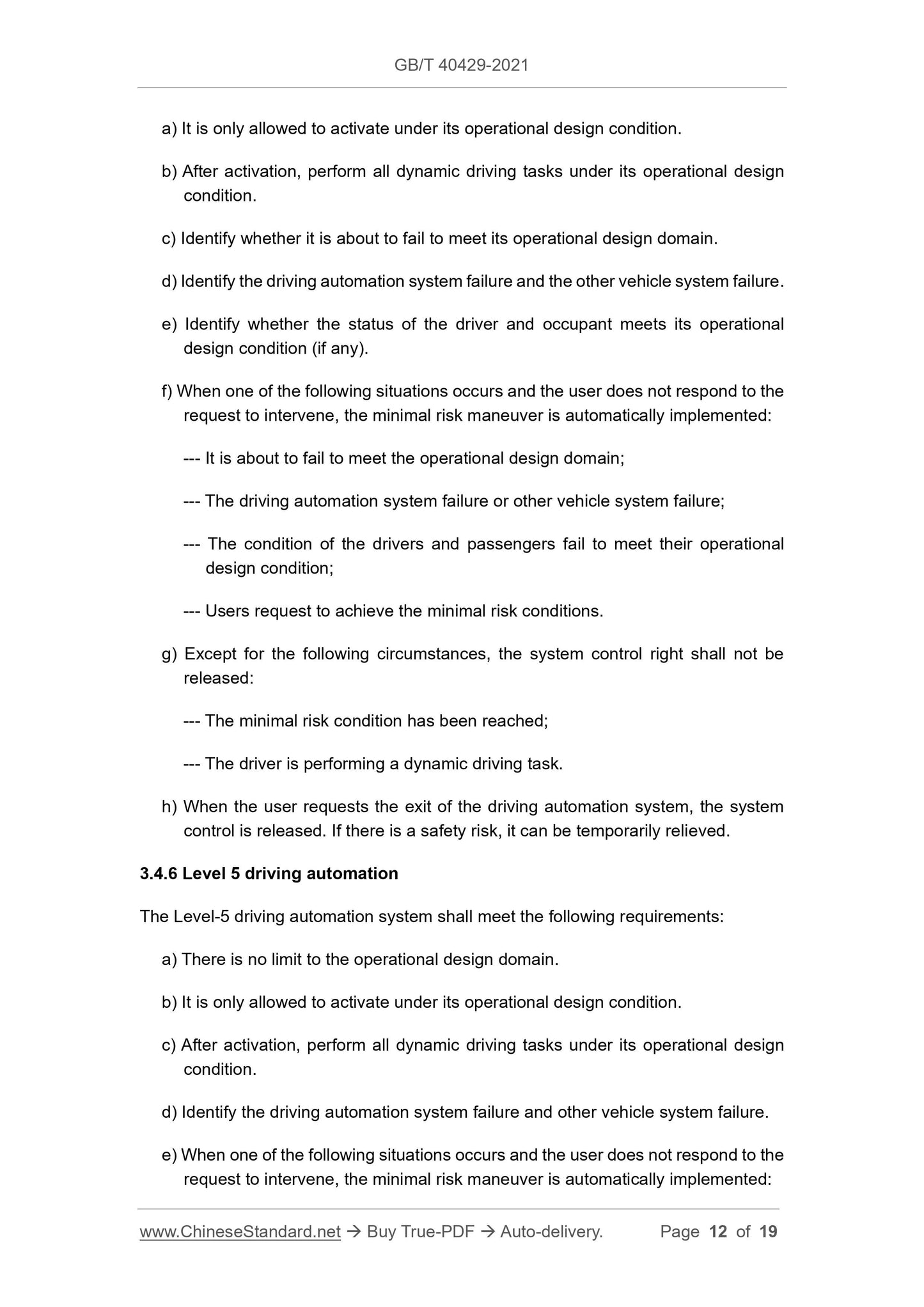1
/
of
8
PayPal, credit cards. Download editable-PDF and invoice in 1 second!
GB/T 40429-2021 English PDF (GBT40429-2021)
GB/T 40429-2021 English PDF (GBT40429-2021)
Regular price
$230.00 USD
Regular price
Sale price
$230.00 USD
Unit price
/
per
Shipping calculated at checkout.
Couldn't load pickup availability
Delivery: 3 seconds. Download true-PDF + Invoice.
Get Quotation: Click GB/T 40429-2021 (Self-service in 1-minute)
Historical versions (Master-website): GB/T 40429-2021
Preview True-PDF (Reload/Scroll-down if blank)
GB/T 40429-2021: Taxonomy of driving automation for vehicles
GB/T 40429-2021
Taxonomy of driving automation for vehicles
ICS 43.020
T40/49
National Standards of People's Republic of China
Car driving automation classification
Released on 2021-08-20
2022-03-01 implementation
State Administration for Market Regulation
Issued by the National Standardization Management Committee
Table of contents
Foreword Ⅰ
1 Scope 1
2 Terms and definitions 1
3 Driving automation classification 3
3.1 Principles of driving automation classification 3
3.2 Classification elements of driving automation level 4
3.3 Classification of driving automation levels 4
3.3.1 Level 0 driving automation 4
3.3.2 Level 1 driving automation 4
3.3.3 Level 2 driving automation 4
3.3.4 Level 3 driving automation 4
3.3.5 Level 4 driving automation 4
3.3.6 Level 5 driving automation 5
3.4 Technical requirements for each level of driving automation 5
3.4.1 Level 0 driving automation 5
3.4.2 Level 1 driving automation 5
3.4.3 Level 2 driving automation 5
3.4.4 Level 3 driving automation 5
3.4.5 Level 4 driving automation 5
3.4.6 Level 5 driving automation 6
Appendix A (informative appendix) The relationship between driving automation levels and division elements 7
Appendix B (informative appendix) The role of users and driving automation systems 8
Car driving automation classification
1 Scope
This standard specifies the classification of automotive driving automation functions.
This standard applies to M and N vehicles with driving automation functions, and other types of vehicles can be implemented by reference.
2 Terms and definitions
The following terms and definitions apply to this document.
2.1
Drivingautomation
The behavior of the vehicle continuously performing part or all of the dynamic driving tasks in an automatic manner.
2.2
Drivingautomationsystem
A system composed of hardware and software for driving automation.
2.3
Drivingautomationfeature
The ability of a driving automation system to perform some or all dynamic driving tasks within specific design operating conditions.
Note. A driving automation system can realize one or more driving automation functions, each function with specific driving automation level and design operating conditions
Associated. In order to accurately describe the capabilities of a driving automation system, it is necessary to clarify its driving automation level and design operating conditions at the same time.
2.4
Dynamic driving task dynamic driving task; DDT
In addition to strategic functions, the perception, decision-making, and execution behaviors required for vehicle driving include but are not limited to.
--- Vehicle lateral movement control;
---Vehicle longitudinal motion control;
---Target and event detection and response;
---Driving decision;
---Vehicle lighting and signal device control.
Note 1.Strategic functions such as navigation, itinerary planning, destination and route selection, etc.
Note 2.Dynamic driving tasks are generally completed by the driver, the driving automation system, or both.
2.5
Lateral vehicle motion control
Real-time vehicle motion control along the Y axis (as shown in Figure 1) in dynamic driving tasks.
2.6
Longitudinal vehicle motion control
Real-time vehicle motion control along the X axis (as shown in Figure 1) in dynamic driving tasks.
2.16
Other vehicle system failure
The failure of other systems of the vehicle other than the driving automation system causes the driving automation system to be unable to reliably perform some or all of the actions.
Driving tasks.
Example. brake caliper failure, etc.
2.17
User
A collective term for human roles related to driving automation.
Note. The user's role can be converted under certain conditions.
2.17.1
Driver
For a specific vehicle, a user who performs some or all dynamic driving tasks and/or takes over in real time.
2.17.1.1
Conventionaldriver
Sitting in the driver's seat, directly operating the vehicle's braking, acceleration, steering, and shifting control devices to control the vehicle in a manual manner
The driver.
2.17.1.2
Remote driver remotedriver
You can still control the car in real time without being in the driver's seat where you can directly operate the vehicle's braking, acceleration, steering, and shifting control devices.
The driver of the car.
Note. The remote driver can be a user in the car, a user whose vehicle is within its field of view, or a user whose vehicle is outside of its field of view.
2.17.2
Passenger
In the car, but does not assume any dynamic driving tasks and take over the user.
2.17.3
Dynamic driving task support user DDTfalback-readyuser
When the level 3 driving automation system is working, it can identify intervention requests issued by the driving automation system and obvious dynamic driving tasks
The related vehicle malfunctions and the user performs a takeover.
Note 1.This term applies to level 3 driving automation functions, level 4 and 5 do not have this role. The dynamic driving task support user can be in or outside the car.
Note 2.The dynamic driving task support user becomes the driver when performing part or all of the dynamic driving task.
2.17.4
Dispatcher
Under the condition that the vehicle is not operated by the driver, activate the driving automation system to realize the vehicle dispatch service but not perform dynamic driving
The user of the task.
Note. Only vehicles with level 4 and level 5 driving automation functions and their designed operating range covering the entire journey can be dispatched. If driving automation system
Without planning the route, the dispatcher still needs to specify the destination.
3 Classification of driving automation
3.1 Principles of driving automation classification
Based on the degree to which the driving automation system can perform dynamic driving tasks, according to the role assignment in the execution of dynamic driving tasks and
Whether there are restrictions on the design operation range, the driving automation is divided into 0 to 5 levels. See Appendix A for the relationship between driving automation levels and division elements.
See Appendix B for the roles of users and driving automation systems.
3.2 The elements of driving automation level classification
The driving automation level is divided based on the following 6 elements.
---Whether the driving automation system continues to perform target and event detection and response in dynamic driving tasks;
---Whether the driving automation system continuously executes the lateral or longitudinal motion control of the vehicle in dynamic driving tasks;
---Whether the driving automation system continuously executes the lateral and longitudinal motion control of the vehicle in dynamic driving tasks at the same time;
---Whether the driving automation system continues to perform all dynamic driving tasks;
---Whether the driving automation system automatically implements the minimum risk strategy;
---Whether there is a limit to the design operation range of the driving automation system.
3.3 Classification of driving automation levels
3.3.1 Level 0 driving automation
Level 0 driving automation (emergency assistance) system cannot continuously perform vehicle lateral direction in dynamic driving tasks
Or longitudinal motion control, but has the ability to continuously perform part of the target and event detection and response capabilities in dynamic driving tasks.
Note 1.Level 0 driving automation is not no driving automation. Level 0 driving automation system can perceive the environment and provide prompt information or intervene in vehicle control briefly.
To assist the driver in avoiding danger (such as lane departure warning, forward collision warning, automatic emergency braking, lane departure suppression and other emergency situations assistance
Function).
Note 2.Functions that do not have target and event detection and response capabilities (such as cruise control, electronic stability control, etc.) are not within the scope of driving automation functions.
3.3.2 Level 1 driving automation
Level 1 driving automation (partial drive assistance, partial drive rassistance) system continuously executes actions under its designed operating conditions
The vehicle's lateral or longitudinal movement control in the state of the driving task, and has a part that is compatible with the executed vehicle's lateral or longitudinal movement control
The ability to detect and respond to targets and events.
Note. For level 1 driving automation, the driver and the driving automation system jointly perform all dynamic driving tasks and supervise the behavior and behavior of the driving automation system.
Perform appropriate response or operation (such as lane centering control, adaptive cruise control, etc.).
3.3.3 Level 2 driving automation
Level 2 driving automation (combined drive assistance, combined drive rassistance) system continuously executes under its design operating conditions
Vehicle lateral and longitudinal motion control in dynamic driving tasks, and has parts that are compatible with the executed vehicle lateral and longitudinal motion control
The ability to detect and respond to targets and events.
Note. For Level 2 driving automation, the driver and the driving automation system jointly perform all dynamic driving tasks and supervise the behavior and behavior of the driving automation system.
Perform the appropriate response or action.
3.3.4 Level 3 driving automation
Level 3 driving automation (conditionalyautomateddriving) system continues under its design operating conditions
Carry out all dynamic driving tasks accurately.
Note. For level 3 driving automation, the dynamic driving task supports the user to perform the takeover in an appropriate way.
3.3.5 Level 4 driving automation
Level 4 driving automation (highlyautomateddriving) system continuously performs full
Dynamic driving tasks and automatically implement the minimum risk strategy.
Note 1.For Level 4 driving automation, when the system issues an intervention request, the user may not respond, and the system has the ability to automatically reach the minimum risk state.
Note 2.Some vehicles with Level 4 driving automation system have no manual driving function, such as park shuttle buses.
3.3.6 Level 5 driving automation
Level 5 driving automation (fulyautomateddriving) system continuously performs full driving under any driving conditions
Dynamic driving tasks and automatically implement the minimum risk strategy.
Note 1.For level 5 driving automation, when the system issues an intervention request, the user may not respond, and the system has the ability to automatically reach the minimum risk state.
Note 2.Level 5 driving automation has no restrictions on the design operating range in the vehicle's drivable environment (except for restrictions such as commercial and regulatory factors).
3.4 Technical requirements for various levels of driving automation
3.4.1 Level 0 driving automation
Level 0 driving automation system should meet the following requirements.
a) Have the ability to continuously execute part of the target and event detection and response;
b) When the driver requests the exit of the driving automation system, immediately release the system control.
Note. When the lane departure suppression system is working, the driver can actively control the steering wheel to exit the lane departure suppression system.
3.4.2 Level 1 driving automation
Level 1 driving automation system should meet the following requirements.
a) Continuously perform vehicle lateral or longitudinal motion control in dynamic driving tasks;
b) Possess the ability to detect and respond to certain targets and events that are compatible with the vehicle's lateral or longitudinal motion control;
c) When the driver requests the exit of the driving automation system, immediately release the control of the system.
3.4.3 Level 2 driving automation
Level 2 driving automation system should meet the following requirements.
a) Continuously perform vehicle lateral and longitudinal motion control in dynamic driving tasks;
b) Possess the ability to detect and respond to certain targets and events that are compatible with the vehicle's lateral and longitudinal motion control;
c) When the driver requests the exit of the driving automation system, immediately release the control of the system.
3.4.4 Level 3 driving automation
The level 3 driving automation system should meet the following requirements.
a) It is only allowed to activate under its designed operating conditions;
b) After activation, perform all dynamic driving tasks under its design operating conditions;
c) Identify whether the design operating range is about to be not met, and when the design operating range is about to be not met, report to the dynamic driving task in time
Assist the user to issue an intervention request;
d) Identify the failure of the driving automation system, and promptly send the dynamic driving task support users to the dynamic driving task when the driving automation system fails.
Request for intervention;
e) Identify the takeover ability of the dynamic driving task support user, and issue an intervention request when its takeover ability is about to fail to meet the requirements;
f) After the intervention request is issued, continue to perform the dynamic driving task for a certain period of time for the dynamic driving task backup user to perform takeover
operate;
g) After the intervention request is issued, if the dynamic driving task support user does not respond, measures to reduce the risk of the vehicle shall be taken in due course;
h) When the user requests the exit of the driving automation system, immediately release the system control.
3.4.5 Level 4 driving automation
Level 4 driving automation system should meet the following requirements.
a) It is only allowed to activate under its designed operating conditions.
b) After activation, perform all dynamic driving tasks under its design operating conditions.
c) Identify whether it will soon fail to meet its design operating range.
d) Identify the failure of the driving automation sys...
Get Quotation: Click GB/T 40429-2021 (Self-service in 1-minute)
Historical versions (Master-website): GB/T 40429-2021
Preview True-PDF (Reload/Scroll-down if blank)
GB/T 40429-2021: Taxonomy of driving automation for vehicles
GB/T 40429-2021
Taxonomy of driving automation for vehicles
ICS 43.020
T40/49
National Standards of People's Republic of China
Car driving automation classification
Released on 2021-08-20
2022-03-01 implementation
State Administration for Market Regulation
Issued by the National Standardization Management Committee
Table of contents
Foreword Ⅰ
1 Scope 1
2 Terms and definitions 1
3 Driving automation classification 3
3.1 Principles of driving automation classification 3
3.2 Classification elements of driving automation level 4
3.3 Classification of driving automation levels 4
3.3.1 Level 0 driving automation 4
3.3.2 Level 1 driving automation 4
3.3.3 Level 2 driving automation 4
3.3.4 Level 3 driving automation 4
3.3.5 Level 4 driving automation 4
3.3.6 Level 5 driving automation 5
3.4 Technical requirements for each level of driving automation 5
3.4.1 Level 0 driving automation 5
3.4.2 Level 1 driving automation 5
3.4.3 Level 2 driving automation 5
3.4.4 Level 3 driving automation 5
3.4.5 Level 4 driving automation 5
3.4.6 Level 5 driving automation 6
Appendix A (informative appendix) The relationship between driving automation levels and division elements 7
Appendix B (informative appendix) The role of users and driving automation systems 8
Car driving automation classification
1 Scope
This standard specifies the classification of automotive driving automation functions.
This standard applies to M and N vehicles with driving automation functions, and other types of vehicles can be implemented by reference.
2 Terms and definitions
The following terms and definitions apply to this document.
2.1
Drivingautomation
The behavior of the vehicle continuously performing part or all of the dynamic driving tasks in an automatic manner.
2.2
Drivingautomationsystem
A system composed of hardware and software for driving automation.
2.3
Drivingautomationfeature
The ability of a driving automation system to perform some or all dynamic driving tasks within specific design operating conditions.
Note. A driving automation system can realize one or more driving automation functions, each function with specific driving automation level and design operating conditions
Associated. In order to accurately describe the capabilities of a driving automation system, it is necessary to clarify its driving automation level and design operating conditions at the same time.
2.4
Dynamic driving task dynamic driving task; DDT
In addition to strategic functions, the perception, decision-making, and execution behaviors required for vehicle driving include but are not limited to.
--- Vehicle lateral movement control;
---Vehicle longitudinal motion control;
---Target and event detection and response;
---Driving decision;
---Vehicle lighting and signal device control.
Note 1.Strategic functions such as navigation, itinerary planning, destination and route selection, etc.
Note 2.Dynamic driving tasks are generally completed by the driver, the driving automation system, or both.
2.5
Lateral vehicle motion control
Real-time vehicle motion control along the Y axis (as shown in Figure 1) in dynamic driving tasks.
2.6
Longitudinal vehicle motion control
Real-time vehicle motion control along the X axis (as shown in Figure 1) in dynamic driving tasks.
2.16
Other vehicle system failure
The failure of other systems of the vehicle other than the driving automation system causes the driving automation system to be unable to reliably perform some or all of the actions.
Driving tasks.
Example. brake caliper failure, etc.
2.17
User
A collective term for human roles related to driving automation.
Note. The user's role can be converted under certain conditions.
2.17.1
Driver
For a specific vehicle, a user who performs some or all dynamic driving tasks and/or takes over in real time.
2.17.1.1
Conventionaldriver
Sitting in the driver's seat, directly operating the vehicle's braking, acceleration, steering, and shifting control devices to control the vehicle in a manual manner
The driver.
2.17.1.2
Remote driver remotedriver
You can still control the car in real time without being in the driver's seat where you can directly operate the vehicle's braking, acceleration, steering, and shifting control devices.
The driver of the car.
Note. The remote driver can be a user in the car, a user whose vehicle is within its field of view, or a user whose vehicle is outside of its field of view.
2.17.2
Passenger
In the car, but does not assume any dynamic driving tasks and take over the user.
2.17.3
Dynamic driving task support user DDTfalback-readyuser
When the level 3 driving automation system is working, it can identify intervention requests issued by the driving automation system and obvious dynamic driving tasks
The related vehicle malfunctions and the user performs a takeover.
Note 1.This term applies to level 3 driving automation functions, level 4 and 5 do not have this role. The dynamic driving task support user can be in or outside the car.
Note 2.The dynamic driving task support user becomes the driver when performing part or all of the dynamic driving task.
2.17.4
Dispatcher
Under the condition that the vehicle is not operated by the driver, activate the driving automation system to realize the vehicle dispatch service but not perform dynamic driving
The user of the task.
Note. Only vehicles with level 4 and level 5 driving automation functions and their designed operating range covering the entire journey can be dispatched. If driving automation system
Without planning the route, the dispatcher still needs to specify the destination.
3 Classification of driving automation
3.1 Principles of driving automation classification
Based on the degree to which the driving automation system can perform dynamic driving tasks, according to the role assignment in the execution of dynamic driving tasks and
Whether there are restrictions on the design operation range, the driving automation is divided into 0 to 5 levels. See Appendix A for the relationship between driving automation levels and division elements.
See Appendix B for the roles of users and driving automation systems.
3.2 The elements of driving automation level classification
The driving automation level is divided based on the following 6 elements.
---Whether the driving automation system continues to perform target and event detection and response in dynamic driving tasks;
---Whether the driving automation system continuously executes the lateral or longitudinal motion control of the vehicle in dynamic driving tasks;
---Whether the driving automation system continuously executes the lateral and longitudinal motion control of the vehicle in dynamic driving tasks at the same time;
---Whether the driving automation system continues to perform all dynamic driving tasks;
---Whether the driving automation system automatically implements the minimum risk strategy;
---Whether there is a limit to the design operation range of the driving automation system.
3.3 Classification of driving automation levels
3.3.1 Level 0 driving automation
Level 0 driving automation (emergency assistance) system cannot continuously perform vehicle lateral direction in dynamic driving tasks
Or longitudinal motion control, but has the ability to continuously perform part of the target and event detection and response capabilities in dynamic driving tasks.
Note 1.Level 0 driving automation is not no driving automation. Level 0 driving automation system can perceive the environment and provide prompt information or intervene in vehicle control briefly.
To assist the driver in avoiding danger (such as lane departure warning, forward collision warning, automatic emergency braking, lane departure suppression and other emergency situations assistance
Function).
Note 2.Functions that do not have target and event detection and response capabilities (such as cruise control, electronic stability control, etc.) are not within the scope of driving automation functions.
3.3.2 Level 1 driving automation
Level 1 driving automation (partial drive assistance, partial drive rassistance) system continuously executes actions under its designed operating conditions
The vehicle's lateral or longitudinal movement control in the state of the driving task, and has a part that is compatible with the executed vehicle's lateral or longitudinal movement control
The ability to detect and respond to targets and events.
Note. For level 1 driving automation, the driver and the driving automation system jointly perform all dynamic driving tasks and supervise the behavior and behavior of the driving automation system.
Perform appropriate response or operation (such as lane centering control, adaptive cruise control, etc.).
3.3.3 Level 2 driving automation
Level 2 driving automation (combined drive assistance, combined drive rassistance) system continuously executes under its design operating conditions
Vehicle lateral and longitudinal motion control in dynamic driving tasks, and has parts that are compatible with the executed vehicle lateral and longitudinal motion control
The ability to detect and respond to targets and events.
Note. For Level 2 driving automation, the driver and the driving automation system jointly perform all dynamic driving tasks and supervise the behavior and behavior of the driving automation system.
Perform the appropriate response or action.
3.3.4 Level 3 driving automation
Level 3 driving automation (conditionalyautomateddriving) system continues under its design operating conditions
Carry out all dynamic driving tasks accurately.
Note. For level 3 driving automation, the dynamic driving task supports the user to perform the takeover in an appropriate way.
3.3.5 Level 4 driving automation
Level 4 driving automation (highlyautomateddriving) system continuously performs full
Dynamic driving tasks and automatically implement the minimum risk strategy.
Note 1.For Level 4 driving automation, when the system issues an intervention request, the user may not respond, and the system has the ability to automatically reach the minimum risk state.
Note 2.Some vehicles with Level 4 driving automation system have no manual driving function, such as park shuttle buses.
3.3.6 Level 5 driving automation
Level 5 driving automation (fulyautomateddriving) system continuously performs full driving under any driving conditions
Dynamic driving tasks and automatically implement the minimum risk strategy.
Note 1.For level 5 driving automation, when the system issues an intervention request, the user may not respond, and the system has the ability to automatically reach the minimum risk state.
Note 2.Level 5 driving automation has no restrictions on the design operating range in the vehicle's drivable environment (except for restrictions such as commercial and regulatory factors).
3.4 Technical requirements for various levels of driving automation
3.4.1 Level 0 driving automation
Level 0 driving automation system should meet the following requirements.
a) Have the ability to continuously execute part of the target and event detection and response;
b) When the driver requests the exit of the driving automation system, immediately release the system control.
Note. When the lane departure suppression system is working, the driver can actively control the steering wheel to exit the lane departure suppression system.
3.4.2 Level 1 driving automation
Level 1 driving automation system should meet the following requirements.
a) Continuously perform vehicle lateral or longitudinal motion control in dynamic driving tasks;
b) Possess the ability to detect and respond to certain targets and events that are compatible with the vehicle's lateral or longitudinal motion control;
c) When the driver requests the exit of the driving automation system, immediately release the control of the system.
3.4.3 Level 2 driving automation
Level 2 driving automation system should meet the following requirements.
a) Continuously perform vehicle lateral and longitudinal motion control in dynamic driving tasks;
b) Possess the ability to detect and respond to certain targets and events that are compatible with the vehicle's lateral and longitudinal motion control;
c) When the driver requests the exit of the driving automation system, immediately release the control of the system.
3.4.4 Level 3 driving automation
The level 3 driving automation system should meet the following requirements.
a) It is only allowed to activate under its designed operating conditions;
b) After activation, perform all dynamic driving tasks under its design operating conditions;
c) Identify whether the design operating range is about to be not met, and when the design operating range is about to be not met, report to the dynamic driving task in time
Assist the user to issue an intervention request;
d) Identify the failure of the driving automation system, and promptly send the dynamic driving task support users to the dynamic driving task when the driving automation system fails.
Request for intervention;
e) Identify the takeover ability of the dynamic driving task support user, and issue an intervention request when its takeover ability is about to fail to meet the requirements;
f) After the intervention request is issued, continue to perform the dynamic driving task for a certain period of time for the dynamic driving task backup user to perform takeover
operate;
g) After the intervention request is issued, if the dynamic driving task support user does not respond, measures to reduce the risk of the vehicle shall be taken in due course;
h) When the user requests the exit of the driving automation system, immediately release the system control.
3.4.5 Level 4 driving automation
Level 4 driving automation system should meet the following requirements.
a) It is only allowed to activate under its designed operating conditions.
b) After activation, perform all dynamic driving tasks under its design operating conditions.
c) Identify whether it will soon fail to meet its design operating range.
d) Identify the failure of the driving automation sys...
Share
